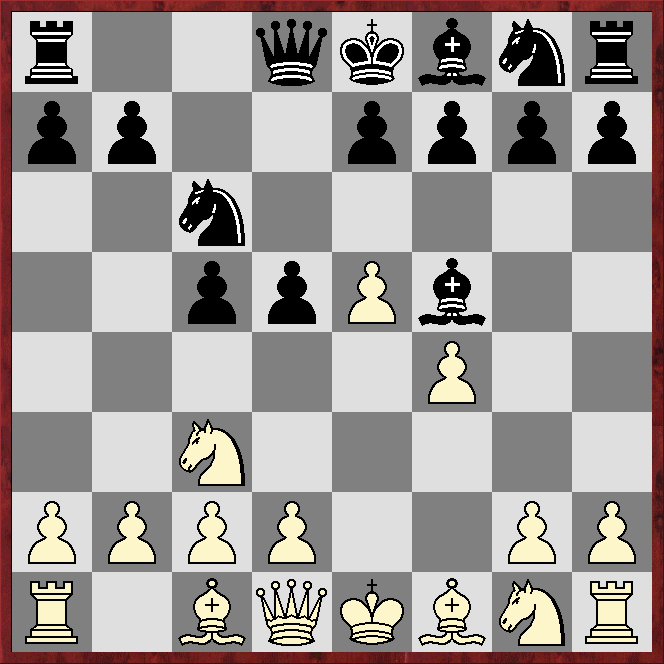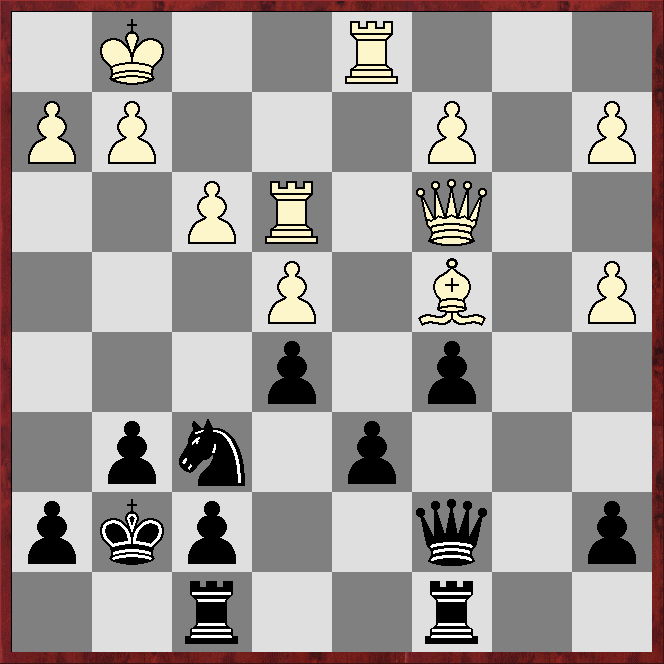Horst Prüsse (2017) - Spanton (1946)Bird/Sicilian 2.f4
1.f4 c5 2.e4 d5!?
This position used to arise very often in the Sicilian when White was trying to play a Grand Prix Attack via the move-order 1.e4 2.c5 2.f4. Nowadays, thanks to 2...d5!?, White usually sets about getting a GPA with 1.e4 c5 2.Nc3 and 3.f4.
 |
| How should White proceed? |
*****
*****
*****
*****
*****
3.e5
The main line in ChessBase's 2025 Mega database runs 3.exd5 Nf6 4.Bb5+ Bd7 5.Bxd7+ (5.Bc4 b5) Qxd7 6.c4 e6 7.Qe2 Bd6!? 8.d3 0-0 9.dxe6 fxe6, when Stockfish17 and Dragon1 reckon Black has more than enough for a pawn.
3...Nc6 4.Nc3 Bf5!?
 |
| How should White respond to this development of the black queen's bishop? |
*****
*****
*****
*****
*****
5.d3
There are no games in Mega25 with 5.g4!?, which the engines reckon should be met with 5...Be6!?
5...h5 6.Be2 h4!? 7.Bg4!? Nh6 8.Bxf5 Nxf5
The square f5 is at least as good an outpost for a knight as for a bishop.
9.Nf3 e6 10.Ng5?!
The engines strongly dislike this.
10...Be7 11.Nh3
Clearly 11.Nf3 would simply represent a serious loss of time, but 11.0-0!? is possible, the point being that after 11...Bxg5 12.fxg5 the capture 12...Nxe5?! is met by 13.Qe1, when White has good compensation for a pawn.
11...f6!? 12.Qg4!? Ncd4 13.Qg6+
This looks natural, but the engines prefer 13.Qd1, or 13.exf6 gxf6 14.Qd1, albeit reckoning Black is on top.
13...Kd7 14.0-0!?
Offering a pawn to get the king to safety in a sharp position looks a reasonable practical decision, but there is a problem.
14...Nxc2 15.Rb1 Qe8! 16.Qg4!?
If queens come off, the uncastled black king no longer has difficulties.
 |
| How should Black proceed? |
*****
*****
*****
*****
*****
16...Nce3
Winning the exchange, but Stockfish17 prefers forcing queens off with 16...Qh5!?, which has a more-human feel to it! Dragon1 agrees with its fellow engine, but to a smaller degree.
17.Bxe3 Nxe3 18.Qe2 Nxf1 19.Rxf1
 |
| Now the smoke has, as it were, cleared, how would you assess the position? |
*****
*****
*****
*****
*****
Black is the pawn and an exchange up, but it does not appear easy to safely open files for black rooks to operate on. White has much the safer king and a lead in development. Nevertheless the engines reckon Black is winning - up the equivalent of more than a minor piece.
19...d4
The engines prefer 19...fxe5!? or 19...f5.
20.exf6 gxf6 21.Ne4 Rc8 22.Rc1 Qh5!
This is the engines' top choice. One idea is to centralise the queen, even at the expense of a pawn.
23.Qc2 Qd5 24.Qa4+ Kd8
Possibly even stronger is 24...Kc7!?, when 25.b4 c4!? 26.Rxc4+ Kb8 gets a pair of rooks off the board - nearly always a good thing for the player an exchange up. But perhaps the simplest solution is 24...Qc6!?
25.Qxa7 c4
The engines prefer 25...Kd7!? or 25...Rg8.
26.Qb6+
They give best as 26.f5!?, eg 26...Qxf5 27.Qxb7 Qe5 28.Nhf2 with complicated play, but they agree Black is still winning.
26...Ke8 27.Nhf2?!
The engines much prefer 27.f5.
27...f5 28.Ng5 Bxg5 29.fxg5 Rg8 30.Nh3 Qe5
Best, according to the engines, is 30...Kd7!?
31.Kf1 Kf7!?
Offering a pawn with check to get the king to relative safety.
 |
| How should White continue? |
*****
*****
*****
*****
*****
32.Re1!?
The engines give 32.Qxb7+ Rc7 33.Qf3, but after 33...cxd3 34.Re1 Qb5! 35.Qh5+ Ke7 Black's attack is at least as dangerous as White's, and Black remains the exchange up.
 |
| Black to keep a winning position with an only-move |
*****
*****
*****
*****
*****
32...Rc6!
Insisting on giving up the b pawn. After 32...Qd5 33.Nf4 White is at least equal, and may have a slight edge (Stockfish17) or even the upper hand (Dragon1) - the position is complicated, but it is very much White who is attacking.
33.Qxb7+ Qc7 34.Qxc7+
There seems nothing better, but the black king no longer faces mating threats.
34...Rxc7
 |
| How would you assess this ending? |
*****
*****
*****
*****
*****
White has a pawn for the exchange, but g5 is weak and Black has good files for the rooks. The engines reckon Black is up the equivalent of a minor piece (Stockfish17) or almost a rook (Dragon1).
35.dxc4
35.Nf4 can be successfully met by 35...c3 or 35...dxc3.
35...Rxc4 36.Nf4 Re8 37.Nd3 Rc2 38.Ne5+ Kg7 39.Rd1 Rd8 40.Nd3 Rd6 41.a4 Rc4
Not 41...Ra6?? 42.Nb4 etc.
42.a5 Ra4 43.b4 Kg6 44.Ne5+ Kg7
Not 44...Kxg5?? Nf7+ and 45...Nxd6.
45.Nc4
If 45.Nd3, then 45...Ra3 is good.
45...Rd8!? 46.Rb1 d3 47.Ke1 Rd4 48.Ne5?
Obviously bad, but Black's advantage has anyway grown to the equivalent of a little more than a rook (Stockfish17) or even almost the equivalent of a rook and a minor piece (Dragon1).
48...Re4+ 0-1




























































